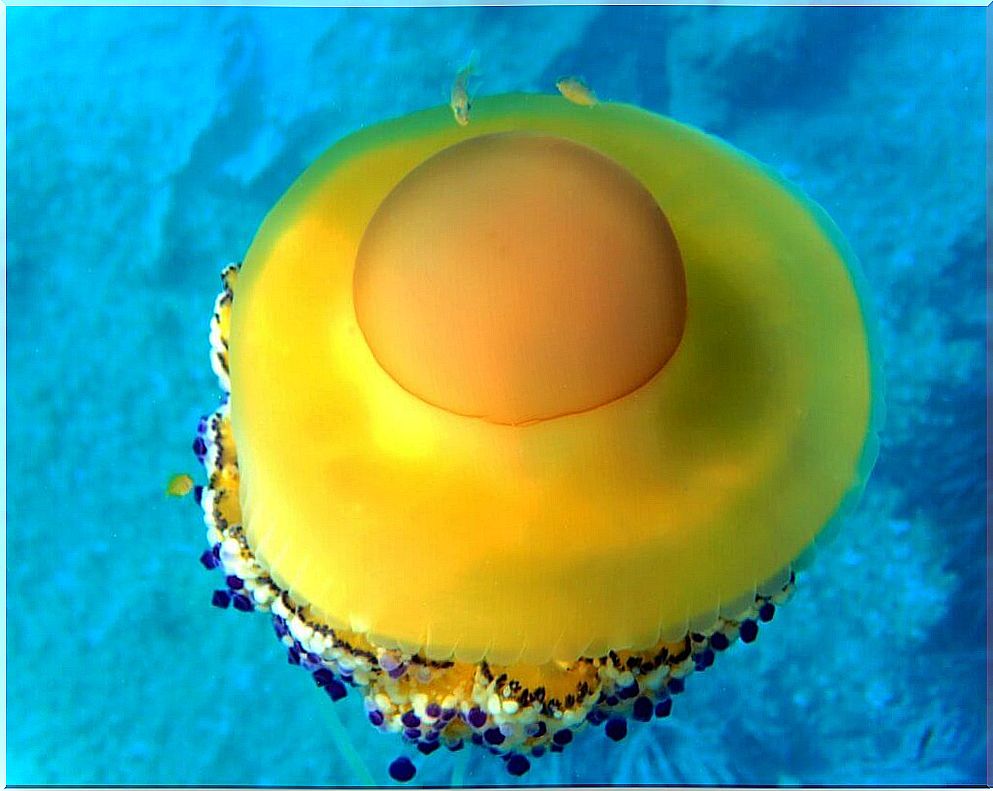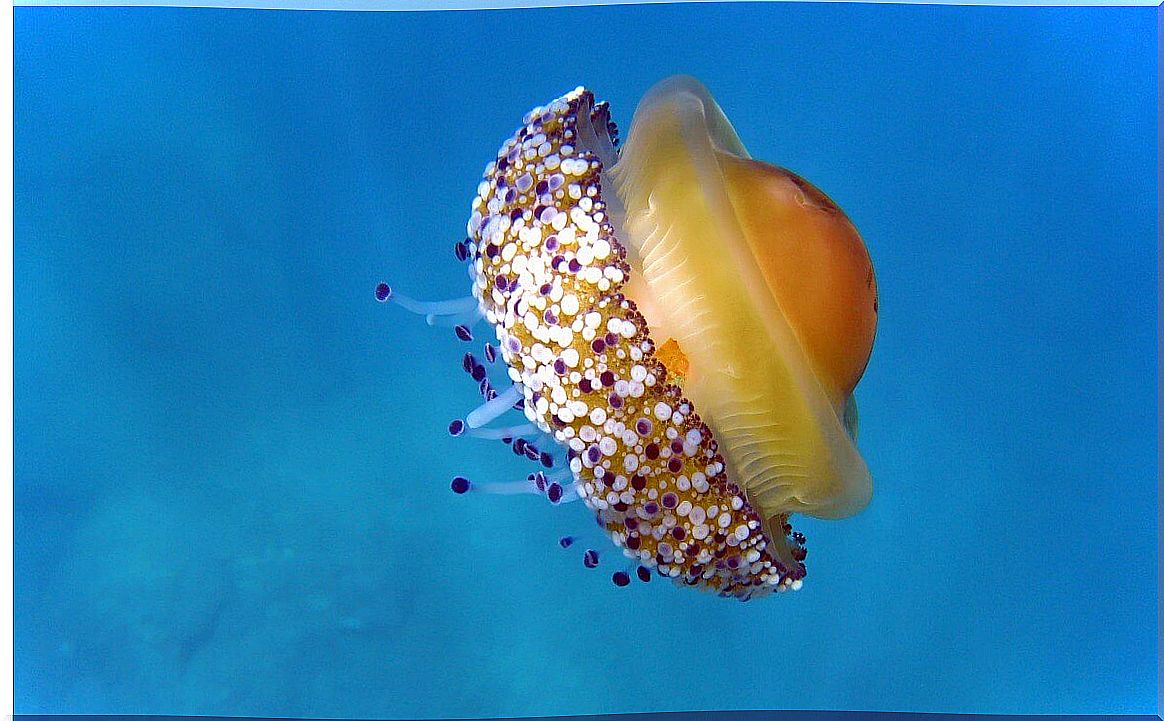Fried Egg Jellyfish: Distribution, Characteristics And Feeding

If you’re used to diving in the ocean, you can find one of the oldest animals in Earth’s history: the fried egg jellyfish. It cannot be denied that she has a curious name, to say the least. This pelagic invertebrate primarily resides in the waters of the Mediterranean Sea, although it is also found in the Aegean Sea, Adriatic Sea and Mar Menor.
Can you say what are the reasons why this invertebrate receives this name? In fact, the answer is within easy reach, just look at the cover photo. But do you know what are the characteristics that differentiate it from other jellyfish? Don’t worry, we’ll answer these and many more questions here.
Characteristics of fried egg jellyfish
Before mentioning the characteristics of this animal, we consider it essential to resolve the doubt about the name. Why is this cnidarian called ‘fried egg jellyfish’? Quite simply, because of the shape of your body. Its appearance is very similar to a fried egg, even in color.
If you look at its body plan, it is literally a fried egg, with the yolk sticking out and the face yellow, giving rise to the jellyfish’s own shape. Both the ‘gem’ and the ‘clear’ constitute the umbrella, the name given to your body and which resembles an umbrella or parasol. Now that this question has been resolved, let’s introduce more features of this species.

Member of the Scyphozoa class
The scientific name by which this species is recognized is C. tuberculata , belonging to the Scyphozoa class. As part of scyphozoans, it is characterized by representing the typical image of the jellyfish. However, there are other families of jellyfish, such as the Hydrozoa, which has species as curious as the blue button jellyfish, Porpita porpita .
they swim vertically
When you imagine movement in a certain way, you visualize the ‘opening’ and ‘closing’ of the body. The fried egg jellyfish, in turn, swim vertically through the contraction and expansion of its umbrella. Likewise, it can also turn its body and travel across the sea.
Its size is variable
When talking about the average diameter of this invertebrate, it is necessary to emphasize that it is a variable measure. In other words, it is possible to find specimens that exceed 40 centimeters, as well as individuals that barely reach 20 centimeters.
There are other species that do not reach 10 centimeters and others that exceed one meter. However, in the Mediterranean Sea, C. tuberculata can be said to hold the title of largest jellyfish, although it rivals Rhizostoma pulmo.
The color of the fried egg jellyfish is fascinating
Among the most striking features of this jellyfish, the shades of its umbrella stand out, as well as other parts of its body. When observing the body formation of this invertebrate, it is possible to notice colors that vary from white to cream or light brown.
In addition, the central part differs from the rest of the body with a stronger tone, which can range from red to dark brown. Also, let’s not forget its purple tentacles that sometimes change color, something that can be an indication of the quality of the water.
It has an entourage that follows it everywhere
Although this jellyfish’s tentacles are full of venom and can explode at any time, some fish are immune to its toxins, such as horse mackerel. Thanks to this association, the fish receive protection from this jellyfish or take advantage of the food that this species has not finished digesting.
May cause painful stings
As you may already know, jellyfish release a stinging mucous substance when their tentacles touch a living thing. However, the method by which the jellyfish release the poison is quite unique. Basically, this occurs through cells called cnidocytes , present in the tentacles. This substance usually causes severe itching and is not pleasant for humans.
If you are unlucky enough to receive a jellyfish sting, look for the nearest emergency room. Do not try to apply traditional solutions that make the itching worse, as in many cases the cnidocytes become embedded in the skin. Under these conditions, medical intervention is essential.
The fried egg jellyfish sting is treated easily and quickly with a magnesium sulfate remedy diluted in salt water. Therefore, it cannot be considered dangerous for humans.
Distribution and feeding of fried egg jellyfish
Although you probably prefer the name ‘fried egg jellyfish’, this cnidarian is also known as ‘Mediterranean jellyfish’. Thanks to its surname, it is possible to quickly locate the main distribution of this pelagic invertebrate. However, it is also present in the Adriatic, Aegean and Minor seas.
Regarding food, these invertebrates capture the small animals that are trapped between any of their 8 tentacles. When eating, they are brought to the mouth, which is located at the back of the body.
Perhaps your curiosity to see the fried egg jellyfish has been piqued. However, if you find one, be very careful and don’t get too close, as even if it’s dead, it can still bite you. In any case, their presence on the coast starts in August and lasts until October. As temperatures drop, this invertebrate returns to the bottom of the sea.

You can also see this species in the breeding season, close to places with numerous rocks in the water. However, don’t bother her. No matter how simple or curious it may seem, every animal deserves respect.









